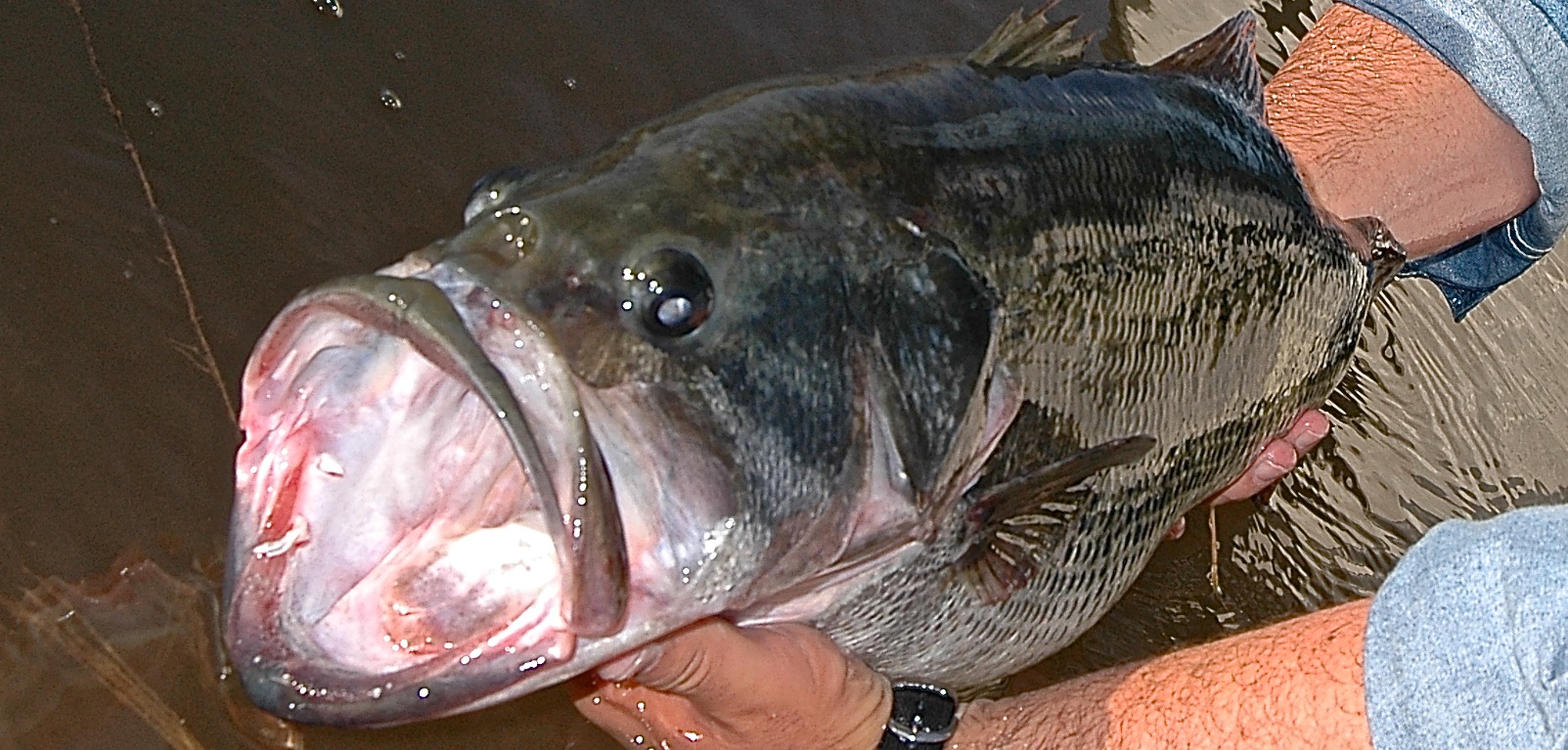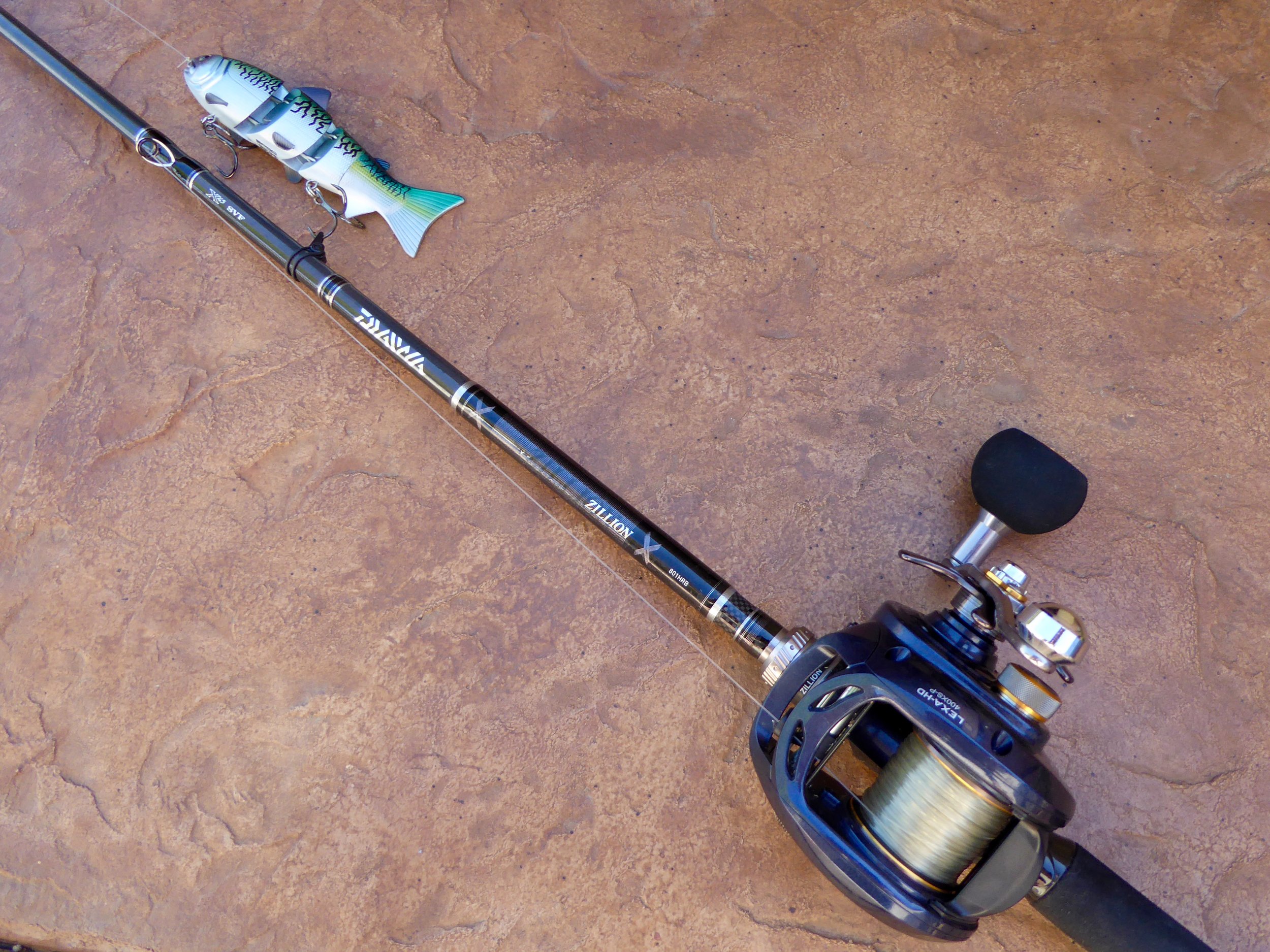Hook Set vs Reel Set. Do You Have The Right Gear To Catch Bigger Fish With Swimbaits?
Siemantel getting ready to release a 15lbs bass
Improving hookup percentages under any circumstances is crucial, but nowhere is it more pronounced than in open water. This is especially true with swimbaits - highly effective lures with notoriously low strike-to-hookup ratios.
It's just one of the subjects that will be addressed in the coming years as more anglers come to the big-bait party. Haven't heard anyone talk about this problem yet? It's probably because most of the so-called "swimbait experts" out there haven't thrown these lures enough, or in enough different situations, to understand the dilemma.
If you're simply casting and retrieving these baits in shallow water, you could write missed strikes off to bad luck. Or, you may not even recognize that some subtle bumps and thumps are actually hits. But when a big bass is tracking your swimbait in open water, things get more complicated. The fish can attack from any number of angles – which makes your decisions all the more critical.
Are your main and stinger hooks properly positioned? Is your retrieve speed, cadence and boat position dead-on? Have you chosen the right rod, reel and line to make it happen?
Judging from the emails I have been getting, some anglers want to leapfrog past these details to get right to the meat, the heart – the very essence of big-bait fishing. Well, since we don't have the space this week to address everything (you can fish most of this information in the Big Bass Zone Book), let's talk about your tackle and how it affects your technique.
The authors argues upsized baitcasters and the proper sized rod and fishing line to generate more force on a reel-set. The Dawia setup above is a crossover system for both fresh and saltwater fishing.
First off, you have to learn how to do a reel-set. For those who've grown up fishing saltwater, the simple act of reeling as you swing the rod comes naturally. Yes, we know you've probably read something somewhere about setting with your reel. Then why don't you do it? Probably less than 10% of all bass fishermen (and that's being optimistic) use a reel-set in their day-to-day fishing.
For those of you who want specifics, hang on. Understanding how a reel-set makes a difference is all about specifics. At this level, relying on a standard, high-end baitcasting reel is akin to bringing a knife to a gunfight. Not good. No matter what the manufacturers may tell you (remember, most don't know anything about big baits), a normal bass-fishing baitcaster will not hold up. It will not perform. It will, as we say in big-bait land, "grenade" on you.
Daiwa LEXA-HD 400 Gear Ratios from 5.1:1 to 8.1:1. Pick Your Poison.
If you're serious about swimbaits, you need to be equally serious about your tackle and how it performs. Since we have no financial connections to tackle companies in the Big Bass Zone, the following is without sponsor bias. Over years of testing both Shimano 400 Calcutta the new Daiwa LEXA 400 I have been leaning more towards the Daiwa. This is one reel that has proven itself both in durability and performance in the last few years. Obviously, this Daiwa is a size larger than the standard baitcaster you may use. Perhaps other choices exist, like the LEXA 300 but you will have to down size your rod and line to have a balanced system..
Daiwa Zillion 801HRB
When matched to a Daiwa Zillion 801 HRB rod and spooled with Maxima 25-pound mono, the LEXA 400 becomes part of a balanced rig. Moreover, it can deliver a much more forceful hookset when the reel-set is employed.
Lexa 400 Specs. Notice line per turn handle and max drag for each model
Line size and stretch finishes off the system when you have a balanced rod and reel. Maxima 25# is a bench mark when starting. To light of line on a heavy system and you will not be able to fully stretch out the line to get maximum results from your rod and reel. Too heavy of line and your lure performance and distance is effected. Note: Using braided lines changes some of these theroies and is for another post.
For example, with a 8.1:1 gear ratio, the LEXA 400 takes up approximately 43" of inches line with each revolution @ full spool. Thin about it, that is around 14' of line taken in to load your system before you start to sweep your rod. At a distance of 100 feet, this delivers up to 24 pounds-per-square-inch (psi) of force on a combination rod/reel-set (with 4 full revolutions). In layman's terms, reeling first and then sweeping the rod will load the entire system, "rod, reel and line" to their maximum potential and the reels maximum drag setting. By doing just a normal hookset with 25 pound test Maxima UltraGreen Mono (sweeping the rod only) creates between 6 and 7 psi depending on body position and rod angle to the fish when it strikes. If you are out of position you may only get 3 to 4 psi on the hook point. It doesn't take a math major to see that a reel-set is a better deal and helps offset bad body position.
Outstanding reel if matched with the proper sized rod and line. Put too small of reel on a big rod and performance is lost.
What may not be as obvious is the amount of force generated by a more standard, but still quality baitcaster such as the Daiwa TATULA-HD200. Spooled with 20-pound Maxima UltraGreen mono, this 6.3:1 reel takes up 28"" inches of line per revolution @ full spool, yet can only generate 9 to 11 psi on a rod/reel-set with the bigger Zillion 801 rod and 4 to 5 1/2 psi with a normal hookset at a distance of 100 feet. The standard hook set with the smaller reel looses power somewhere within the hookset and line stretching with the undersized reel.
Even more surprising, the same reel spooled with 12-pound mono at a distance of 80 feet produces a lesser result as it does with the heavier line because of line stretch again - 5-7 psi on the rod/reel-set and 4 psi with the normal hookset if paired with the smaller reel and lighter line on the bigger rod.
Since we're more interested in catching big bass than understanding physics, it's safe to say that the construction and dimensions of standard baitcasters don't lend themselves to effective hooksetting with big baits. You need something that's bigger, stronger and better balanced to the rest of your tackle.
For some, the argument against reels that have remarkably low gear ratio of 4.7 to 1. The immediate response would be to point up the strength found in lower gear ratios (in most cases after you are hooked up). True, yet not the whole story. With swimbaits, proper presentation is all about speed and cadence. Blazing retrieves are not what make the big baits work all the time. Rather, it's a rhythmic cadence and proper tail kick that produce results.
To achieve this, you need a reel that helps you maintain the proper presentation from start to finish. Remember, you take in more line the closer the lure gets to the reel. A slower reel that has a smaller gear ratio can give you a better speed and cadence control from start to finish but that is only if you understand what it is doing. If you find yourself with a balanced system even if it has a higher gear ratio like the Daiwa LEXA 400 8.1:1 the old adage of "when you think you are going slow, go slower" still stands true, but your Reel Force and faster line pickup may hook the fish of your dreams better to get them to the boat. You also have the option to get lower gear ratios with the Lexa 400 now with gear ratios down to a 5.1:1, so it comes down to what you like.
A truly balanced system will work with swimbaits / bigbaits in both fresh and salt water.
For me using the Daiwa 8.1:1 now for both fresh and saltwater, I like the higher gear ratio because it is easier for me to slow way down then trying to reel so fast when I need to bring in the bait or catch up to a fish because of a slow gear ratio.
Most rod and reel companies out there now-a-days have quality equipment. The key to hooking and catch bigger fish is understanding that you need a fully balanced system (rod, reel and line). After that, know your reel gear ratios to calculate line taken in per revolutions. Remember that stats that say 28" per revolutions is only at full spool. Reels with narrow, deep spools with throw those numbers out of whack very quick. If you throw a big bait to the point of half of spool you may only start out bringing in 14" per turn and quickly increase from there. Shallow, wide spools help but then you have to understand gear ratios. Now matter if you like low (4.7:1) or high (8.1:1) you still have to think a little to stay within the BBZ mindset.
Final Thought! Above you will see 8.1:1 to 5.1:1. In throwing any type or lure or bait, things that create more resistance (like a "Billed" lure) are easier to fish with a lower gear ratio so pick wisely.
Siemantel with a nice Calico after the "Reel Set" technique.










